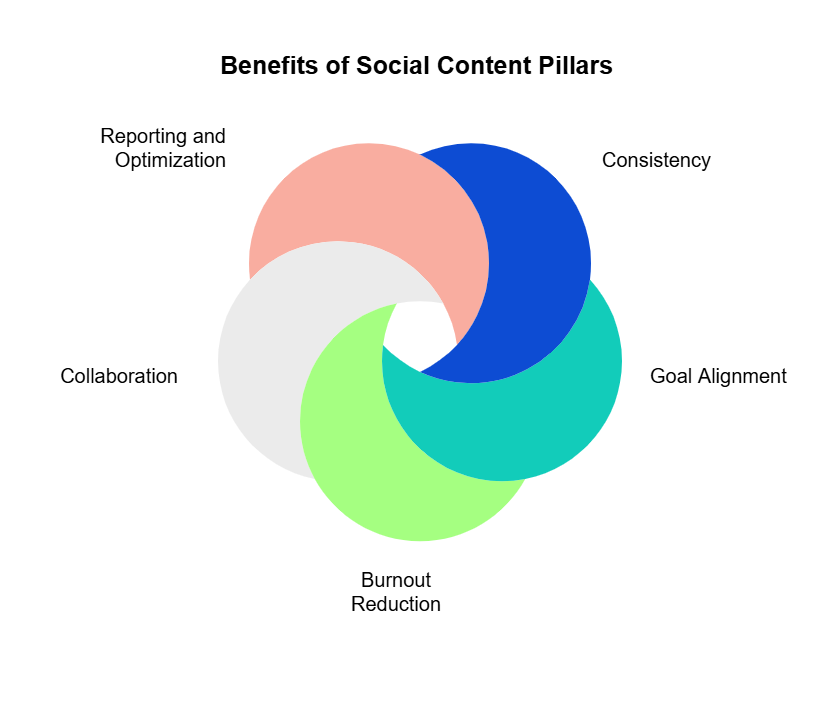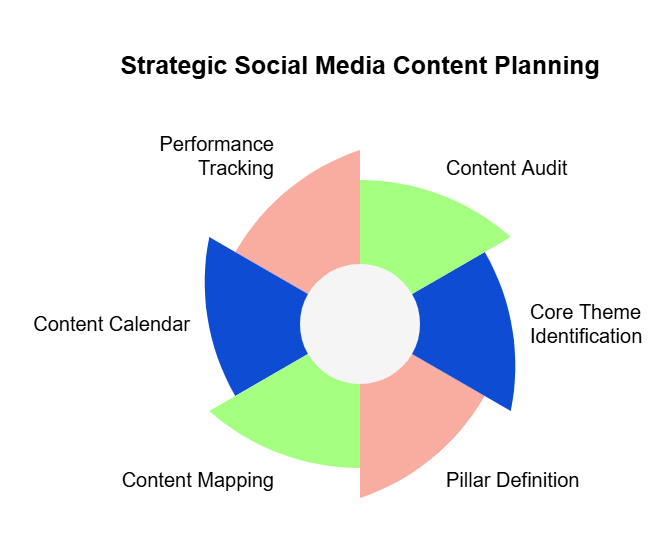Scroll through Duolingo’s TikTok and you’ll notice something: Its consistent whimsy and attitude. One post might show the owl roasting users who skipped a lesson. Another might lean into pop culture or trending audio.
But every piece fits into a few clear themes. There’s brand humor, learning motivation, and user culture. That’s not by accident. Their content fits into organized categories that are relevant to their user base.
It’s easy to think that social media success is rooted in chasing every trend (and succeeding with a viral moment). There’s no doubt that’s a big part of it, but never underestimate the power of building a repeatable framework that helps your team move fast without losing the plot.
We call this structure social media content pillars, and they’re an important part of building a social presence that serves your goals.
What are social media content pillars?
Content pillars are the key themes that shape your entire social media marketing strategy. They’re broad topic areas that reflect your brand’s priorities and speak directly to what your audience cares about most.
Instead of posting random content or chasing trends, pillars give you a clear framework. They help you plan with intention. Each piece of content you publish should tie back to one of your pillars. This keeps your messaging consistent and avoids repeating the same ideas over and over, especially when you’re working on multiple platforms.
For example, a wellness brand might use pillars like nutrition, movement, mindfulness, and lifestyle habits and not stray into territory like high fashion or best practices for rose gardens. Establish buckets that guide what types of social content to create.
What social content pillars do for your strategy

Content pillars are a valuable planning tool, but they’re also the backbone of a smart and efficient social strategy.
They bring consistency across social media platforms
Pillars help you show up with a clear, unified voice no matter where you’re posting. Whether it's LinkedIn, Instagram, or TikTok, your messaging stays consistent because it’s built around the same foundational themes.
They align posts with brand and business goals
When every piece of content ladders up to a strategic pillar, you're reinforcing your positioning and moving the business forward. It keeps teams focused on what matters, not just what’s trending.
They reduce content creation burnout
When you’re working without a plan, coming up with something to say is exhausting. And whatever you come up with is rarely good.
Pillars give your team direction so you’re not starting from scratch each time. It’s easier to brainstorm, plan, and repurpose when you know the core themes you’re working within.
They help teams collaborate without duplicating efforts
With clear pillars in place, content teams, social teams, and even external agencies can work in parallel. Everyone knows what themes they’re contributing to, which makes workflows smoother and cuts down on repetitive content.
For instance, you might assign news content to the PR team or product content to the product team. This means everyone can produce content that most closely aligns with their expertise.
They make reporting and optimization easier
Tagging content by pillar gives you a cleaner view of what’s driving engagement or conversions. Instead of just tracking by channel or post type, you can see which themes perform best. This lets you double down on what works and move past what does not.
Less is more: The 3-5 pillar rule
Most brands benefit from having three to five content pillars. It’s enough to provide variety without overwhelming your strategy or your audience. This range gives your team a clear focus while still allowing room for creativity and flexibility.
That said, it’s not a hard rule. Some brands may only need two strong pillars, while others might comfortably manage six. The right number depends on your goals, audience, and resources.
Example pillars by brand type
Sometimes just a few examples can get your gears going on what your own pillar strategy might be.
Tech startup: product education, customer success stories, industry insights, team and culture, and tips and tutorials
Health and wellness brand: nutrition, fitness routines, mental health, and lifestyle habits
Enterprise consulting firm: case studies, thought leadership, DEI and company values, talent and hiring, and event coverage
Ecommerce apparel brand: new arrivals and product drops, behind the scenes, style tips and inspiration, user-generated content, and brand values and sustainability
The goal is to choose pillars that reflect both your business goals and what your audience genuinely wants. If a pillar stops serving a purpose (meaning engagement), drop it. If a new opportunity emerges, add it. The structure is meant to guide your work, not box you in.
A quick browse of Duolingo’s TikTok makes it clear that their posts with the highest engagement are just . . . silly. There’s little connection to the product (except for the overall branding), but it’s the kind of content their audience is drawn to.
Examples of social media pillars from real brands
Countless brands use the pillar strategy to shape their social media presence.
1. Adobe
As a creative software company, Adobe organizes much of its content around:
- User creativity and inspiration (featuring customer work)
- Product tips and tutorials
- Brand storytelling and company values
- Industry insights and design trends
Adobe’s Instagram and YouTube channels are full of how-tos and creative showcases, while LinkedIn leans into thought leadership and innovation.
2. HubSpot
HubSpot, a marketing and sales platform, uses similar pillars across its social media platforms, including:
- Marketing education (tips, playbooks, webinars)
- Product education and updates
- Customer success stories
- Company culture and values
3. Nike
Nike’s global brand presence is powered by emotionally resonant content. They don't just sell shoes. They tell stories that reflect their mission and values. Pillars include:
- Athlete stories and empowerment
- Product highlights and innovation
- Community impact and social justice
- Fitness and movement inspiration
4. Shopify
Shopify leans into its role as a partner for entrepreneurs. Its content encourages and equips small businesses to grow online. Pillars include:
- Founder and merchant stories
- Ecommerce tips and data insights
- Product features and tools
- Motivational content around entrepreneurship
5. IBM
IBM targets an enterprise audience with effective content pillars that reflect its tech expertise and leadership. This is a good example of a brand that scales across a global audience while still being consistent with its messaging. Its pillars are:
- AI and emerging technology insights
- Enterprise innovation and case studies
- Sustainability and social impact
- Talent and thought leadership
- Promotional content
6. Glossier
Glossier, a beauty brand, is a strong example of using visual storytelling to reinforce brand identity. Its content is built on community and simplicity:
- User-generated content and real customer stories
- Product education and skincare routines
- Behind-the-scenes brand moments
- Minimalist lifestyle and self-care
How to use content pillars for social media

Once you’ve defined your content pillars, the real value comes from how you put them to work.
Audit your existing content for patterns and gaps
Start by reviewing your recent social media posts across platforms. You may be working off informal content pillars already.
Group your posts by theme or topic to spot natural patterns. What do you talk about often? What’s missing?
Look at performance data to see which types of content resonate most. This step helps you avoid duplicating what’s not working and double down on what is. It also reveals gaps where your content could better align with brand messaging or user needs.
Identify 3-5 core themes that align with your brand and audience
Use your audit to define three to five high-value content themes. Each one should reflect a key brand message or customer interest. These are your content pillars.
Your pillars should be broad enough to support a variety of content, but specific enough to keep your strategy focused. For example, “Product Education” might cover tutorials, demos, and FAQs.
Most importantly, choose themes you (or someone on your team) can speak to with authority and consistency over time.
Create clear definitions and examples for each pillar
Write a short description for each pillar so your team knows what belongs under it. Include example post types, formats, or angles that fit. This step removes ambiguity, especially when you’re working with large teams or outside agencies.
For instance, your “Customer Success” pillar might include testimonials, case studies, or user spotlights. Include examples of the types of content that apply to that category. Ideally, these examples should come from your profiles.
This documentation is a good place to link to your brand guidelines so the creator has everything they need to produce the right kind of content.
Map each pillar to specific content formats and channels
Decide how each pillar shows up across your platforms. Maybe thought leadership lives on LinkedIn, product demos go on YouTube, and behind-the-scenes content works best for Instagram Stories.
Think about what format works best for each theme, and tailor your approach by channel. This avoids copy-paste posting so every platform plays to its strengths.
Build a content calendar around your pillars
Use your pillars to structure your social media marketing calendar. Rotate through themes to keep content fresh while staying consistent. Week one might focus on “Industry Insights,” week two on “Customer Stories,” and so on.
This framework streamlines your planning and makes batching content easier. For example, you could produce 20 customer spotlights in a sprint and then schedule them throughout the year based on your calendar.
This system also helps prevent over-posting in one area while neglecting others.
Tag and track performance by pillar
Go beyond channel-level reporting. Tag each social media post by its content pillar and measure how it performs. Which content themes are getting the most engagement, clicks, or shares? Which ones are underperforming?
Furthermore, examine which pillars actually serve your goals. If you want product awareness, are people clicking through to learn more? If you want conversions, are those posts driving measurable sales or sign-ups?
This data helps you fine-tune your content strategy and reallocate resources toward what’s working. Over time, you’ll get a clearer picture of which pillars are driving real business value.
Go beyond channel-level reporting. Tag each post by its content pillar and track how it performs. Which themes are generating the most engagement, clicks, or shares? Which ones are falling flat?
Tracking social metrics like engagement rate (likes, comments, shares, saves), reach, and impressions is important, but don’t forget to track the KPIs that matter to your business goals. These depend on your goals but might include some of the following:
- Website traffic from social channels
- Lead generation and form fills
- Conversion rates and attributed revenue
- Product sales from social posts
Tools like Sprout Social, Hootsuite, or HubSpot are helpful for tagging and categorizing relevant content. Platforms like Google Analytics, Meta Business Suite, and LinkedIn Campaign Manager can help connect pillar performance to site behavior and conversions.
UTM tagging is also essential here. By appending your URLs with bits of code, analytics platforms can trace traffic and conversion paths back to specific content themes. This data can help you learn about how users arrive on your site and what they explore.
Refine your pillars based on results and feedback
Your social media content pillars aren’t set in stone. Use performance data, team feedback, and market changes to revisit your content pillar strategy every few months.
If a pillar is underperforming or no longer aligned with your goals, consider retiring or evolving it. Likewise, be open to adding new ones when opportunities arise.
If you scroll back years through a brand’s social media feed, you’ll see definite shifts in their social strategy. This is totally normal. It’s likely a sign of a brand that knows how to stay relevant.
Share pillar guidelines with internal teams and stakeholders
Once your pillars are defined, make sure everyone who touches social media knows how to use them. Document the pillars, their definitions, and examples in an easy-to-share format.
This keeps everyone on the same page, whether they’re creating content, reviewing campaigns, or reporting results. It also makes sure everyone produces consistent work that stays inline with your branding.
Pillars provide performance
Content pillars give your social media strategy structure, focus, and longevity. Instead of scrambling for ideas or chasing trends, you build around core themes that support your goals and speak to your audience.
The result is smarter planning, stronger messaging, and content that moves the needle.

